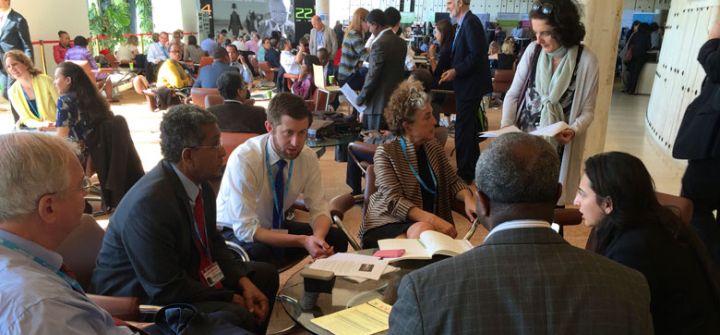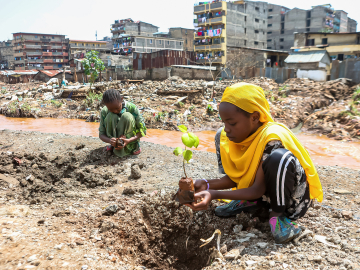Attention Finally for a Neglected Disease
Ahmed Fahal (second from left) and other mycetoma researchers plot their next steps at the World Health Assembly in Geneva.
GENEVA—By the time mycetoma—a terrifying and obscure tropical infection—reached the discussion floor of the World Health Assembly at the end of last week, most officials had flown home. And because it had been pushed back until late on the last day, the Sudanese delegation was not at the Assembly when the deliberations began—when mycetoma unexpectedly bounced forward.
So, poetically, it was Ahmed Fahal, the Sudanese director of the world’s only Mycetoma Research Center, who remained to ask WHO’s member nations to make the condition number 18 on the official list of 17 neglected diseases.
“Mycetoma affects the poorest of the poor in remote communities,” Fahal told the Assembly. “The patients are of low socioeconomic status, they have a lot of problems.” Fahal had not expected to deliver an address, but his words flowed from the heart. If mycetoma could not be added to the list, donors who fund research and medicine would continue to overlook people in two dozen nations who suffer with limbs and lungs overwhelmed by flesh-eating microbes.
On behalf of 47 countries in the African region, the delegate from Niger leant Fahal support. “It is a chronic inflammatory and destructive disease which infects the skin, flesh, and bones,” she said. “It also has very serious negative social and economic consequences for the people affected.” Moreover, the delegate added, progress could be made. A Geneva-based public-private partnership called the Drugs for Neglected Disease initiative had begun a clinical trial on a new treatment for the disease at Fahal’s Mycetoma Center in Khartoum. “The Africa region gives strong support to any action that might lead to assistance given to that Center so they can increase the knowledge of this disease and strategies to fight against it,” the Niger delegate said.
Saudi Arabia, Kenya, Iraq, Korea, Japan, Thailand, and South Africa echoed their support for the addition. As did the United States, which had not done so during the WHO’s Executive Board meeting in January. When the resolution passed at 10am Saturday morning—meaning mycetoma would be added to the WHO’s Neglected Tropical Disease list—tears welled up in Fahal’s eyes. Members of DNDi who watched the Assembly from the peanut gallery started to cry. They hustled into the lobby and embraced Fahal.
“This is everything,” Fahal said, his voice cracking. “It’s really big, after a 30-year struggle.”
“It is momentous, we started with nothing, so seeing it discussed and listed is a tremendous step,” said Ed Zijlstra, an infectious disease specialist who met Fahal 15 years ago in Sudan, and has encouraged research on mycetoma ever since.
With mycetoma on the list, the WHO will educate Ministers of Health around the world about the disease as they try to discern how many people have mycetoma, how much death and disability it causes, and how to prevent it. After Buruli ulcer made the neglected disease list 19 years ago, the WHO convened international meetings on the then-mysterious condition and formulated a strategy of attack. The approach has resulted in antibiotic treatments, better diagnostic tests, and a drop in the disease.
For 40 hours before the announcement, Fahal and a motley handful of mycetoma advocates milled anxiously between two auditoriums where the Assembly slowly hashed out the world’s health priorities. Over copious amounts of coffee, the group plotted their next steps. Mehreen Qureshi, a public health graduate student at New York University, told the group she and a classmate would visit 3 villages in Sudan in July to search for people with early-stage mycetoma. “We’ll go door to door and collect information on tablets,” she explained. DNDi’s medical director, Nathalie Strub Wourgaft, suggested some of the infected might be enrolled in the upcoming clinical trial.
“I’ve been in my master’s program for 2 years and you get sick of hearing about HIV, Zika and TB,” Qureshi told me. “Sure, you can get involved in those but it’s hard to feel you’re making a dent since so many players are involved. With mycetoma, there’s so much to do, it’s all open—disease surveillance, environment, medicine,” she said. “I’m just dying to do something that matters.”
A young British doctor, Peter Siordet Scolding, returned from Fahal’s center last month. He shows the gang the mycetoma website he launched called MAGIC (Mycetoma Association for Global Investigation & Collaboration. They chime in with ideas on how to leverage it into a global network. Ed Zijlstra suggests the inclusion of interactive tutorials geared for medical staff who may encounter people infected by mycetoma and not know what to do.
Being on the WHO’s official NTD list means Scolding has a better chance of raising funds to support the site. It also means DNDi will submit proposals for hefty funding from donors who required the WHO’s endorsement.
However, most immediately after the endorsement, Fahal hugged those around him and sent the news to his staff back at the Center in Khartoum. They will have a celebration, he says. “Maybe we will make this International Mycetoma Day.”
Editor’s Note: Amy Maxmen reported on mycetoma in Sudan for the Global Health NOW series, "The Most Neglected Disease.” Mycetoma was the selected as the Untold Global Health Story of 2015 by GHN and the Consortium of Universities for Global Health.
Join the thousands of subscribers who rely on Global Health NOW summaries and exclusive articles for the latest public health news. Sign up for our free weekday enewsletter, and please share the link with friends and colleagues: Subscribe to GHN





